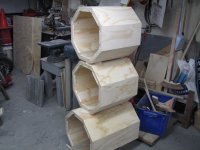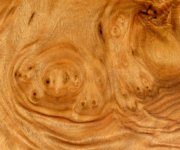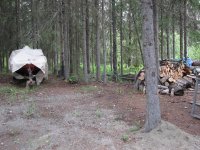I am making some smaller 2 ways at the moment with marine ply, I want the ply to be the final exterior finish so no screws. I am going to use just a few biscuits and rely on but joints and some cleats. Nothing fancy, just softwood braces that will help me to align everything on glue day. Will use PVA glue, stuff is impermeable once set in my experience.
Have always used screws in the past, millions of them. They add up so fast!
Have always used screws in the past, millions of them. They add up so fast!
I suspect you are right Cal, thanks. In that case the cleats are preferable because they will be also add rigidity. On the other hand I have not spun up my biscuit joining thingy for a while so I might whip a few in for good measure 
I used screwed cleats (again to help align things) and butt joint screws and glue in my last sub project. It is ultra tuff!
I used screwed cleats (again to help align things) and butt joint screws and glue in my last sub project. It is ultra tuff!
There is wood glue available that expands and foams upn curing. This one will also fill small gaps and make the cabinet airtight - all at once.
Be aware that you will not be able to remove it from clothes, fingers, furniture ......
I can post a picture of a raw cabinet that used this type of glue if anyone likes.
Regards
Charles
Be aware that you will not be able to remove it from clothes, fingers, furniture ......
I can post a picture of a raw cabinet that used this type of glue if anyone likes.
Regards
Charles
There is wood glue available that expands and foams upn curing. This one will also fill small gaps and make the cabinet airtight - all at once.
Be aware that you will not be able to remove it from clothes, fingers, furniture ......
I can post a picture of a raw cabinet that used this type of glue if anyone likes.
Regards
Charles
But it is not as strong as PVA! Been there done that.
Cal, are your boxes watertight?
PVA even cured will fail with weather exposure. It will take getting wet once or twice.
Glue blocks started with hide glue, you really need them and properly used you rub them to join the panels and no clamping is needed.
Modern glues set differently and clamping is good. The idea when using screws is that they act as clamps until the glue dries and then they really aren't needed. With a modern nail gun run at the proper air pressure the same clamping action happens!
One precaution about modern PVA glues is some have a filler added to allow it to be thicker and extend working time, really don't like that stuff.
The second is never let it freeze.
A semi-serious consideration with wood block reinforced butt joints is the wood used for blocks. When you rip the wood into strips it may warp on you. When buying the wood for the reinforcements look for long straight parallel grain. "Figured" wood is not a good idea. Yes, pines work well. I would avoid red oak, where maple is probably best. Heartwood is particularly good.
I have posted some testing done on wood glues.
http://www.diyaudio.com/forums/construction-tips/194008-lowdown-wood-glues.html#post2660554
http://www.diyaudio.com/forums/construction-tips/194008-lowdown-wood-glues.html#post2660554
You bet, I use them for river rafting during the summer months.Cal, are your boxes watertight?
Mine is air so there aren't cheaper but 5000 nails are pretty cheap. Mind you nailers are fun to use so I probably put about 5 times the nails I need.I haven't bought a nailer in a while, but I thought they cost less than a biscuit joiner and I am pretty sure nails cost less than biscuits.
Yup.PVA even cured will fail with weather exposure. It will take getting wet once or twice.
Unless you attach them to one panel ahead of time. I do that so there are no alignment problems with butt joints. Everything just falls into place. Adding them after defeats that.Glue blocks started with hide glue, you really need them and properly used you rub them to join the panels and no clamping is needed.
Right but I can't remember actually going back and removing them can you?Modern glues set differently and clamping is good. The idea when using screws is that they act as clamps until the glue dries and then they really aren't needed.
Well now let's not forget that even plywood warps a little and the clamps are there to bring the pieces up snug during nailing. 1 1/4" nails aren't so good at that.With a modern nail gun run at the proper air pressure the same clamping action happens!
I use the thicker stuff a.k.a. yellow glue but because it sets up faster not slower.One precaution about modern PVA glues is some have a filler added to allow it to be thicker and extend working time, really don't like that stuff.
I've made that mistake.The second is never let it freeze.

Oh ya, looks like curly fries sometimes.A semi-serious consideration with wood block reinforced butt joints is the wood used for blocks. When you rip the wood into strips it may warp on you.
Is figured wood what we call dimensional lumber ie 2X4? If so I agree. Doesn't stop me from using Spruce though. The Pine in these parts is far too knotty."Figured" wood is not a good idea. Yes, pines work well.
Or - you could use 2 different materials to make the panels, like particle board and ply. Make the inner panel smaller so they form rabbets. It'd take some planning and care laminating but assembly would be fast and you'd get acoustic benefits. Or so I've read. I've made bookcases like this but never speakers. Don't think I'd attempt it on those octagons.
I have laminated really thin ply on the outside of a box as a veneer. I cut it rough and trimmed it with a router, should work for heavier lamiates...
In Australia (at least) there is 'exterior' PVA glue. Not tried it but I assume it would keep Cal afloat longer than the regular stuff... I suppose a bit of damp resistance could matter for PA gear.
Is PVA glue ruined if it freezes in the bottle or just when it is supposed to be curing?
In Australia (at least) there is 'exterior' PVA glue. Not tried it but I assume it would keep Cal afloat longer than the regular stuff... I suppose a bit of damp resistance could matter for PA gear.
Is PVA glue ruined if it freezes in the bottle or just when it is supposed to be curing?
Thanks for the pic. Figured wood looks a little like burl. What are you showing us?Cal,
Attached is what I mean by "Figured" wood.
And if you raise your own pine it would probably be better behaved.
Nothing I raise seems particularly well behaved.
Ya, smarten up would ya?The family Pinaceae covers both commercial spruce and pine forgive me for being so imprecise.
Yes Titebond III calls itself water resistant also. I think that sort of means exterior grade, no?In Australia (at least) there is 'exterior' PVA glue.
There's something long and complicated sounding that happens but what it boils down to is it will work but not near as well so you run the risk of ruing your project.Is PVA glue ruined if it freezes in the bottle or just when it is supposed to be curing?
Throw it away.
Throw it far far away.
Who's Carl?Thanks for the glue test info Carl.
Ya, I was surprised to read the results but like you, nothing I have built has ever suffered. Not like pre-frozen PVA has.Got a shock as I have used gorilla glue a lot in the past, and didn't expect it to be the worse of the bunch!
Though nothing yet I have built with it has fallen apart yet.
You got me curious so I Googled and look what I found in Wiki.
Subfamily Pinoideae
Pinus - pines (about 115 species)
Subfamily Piceoideae
Picea - spruces (about 35 species)
I had no idea there is about 35 species of Spruce. I only know it from the lumber yard or as the trees in behind the wood shed.
Subfamily Pinoideae
Pinus - pines (about 115 species)
Subfamily Piceoideae
Picea - spruces (about 35 species)
I had no idea there is about 35 species of Spruce. I only know it from the lumber yard or as the trees in behind the wood shed.
Attachments
Cal,
Figured wood is what you call any wood with an interesting grain pattern. Nice for the visible wood on furniture, not so nice to keep trued up.
You raise knotty kids?
There are water resistant PVA glues, but if you build a boat with them, better know how to swim.
The folks who classify trees and other things go way overboard.
But West Virginia grown Spruce is different than what you have.
If I travel too far (200 miles or so) I begin to have trouble identifying trees. Of course the local Sycamores are more likely London Plaintrees and telling the difference ain't easy.
I was at the name brand retail store of a mail order chain where a fellow was buying small way overpriced pieces of wood to build a musical instrument. He was tapping the pieces and trying to find the musical ones. I have no idea where he got his ideas of what sound he was listening for, but all the pieces he liked were ones I would have used for secondary uses.
He didn't like dead sounds, but went for wood that had splits in it and gave him many higher frequencies for the same tap.
Figured wood is what you call any wood with an interesting grain pattern. Nice for the visible wood on furniture, not so nice to keep trued up.
You raise knotty kids?
There are water resistant PVA glues, but if you build a boat with them, better know how to swim.
The folks who classify trees and other things go way overboard.
But West Virginia grown Spruce is different than what you have.
If I travel too far (200 miles or so) I begin to have trouble identifying trees. Of course the local Sycamores are more likely London Plaintrees and telling the difference ain't easy.
I was at the name brand retail store of a mail order chain where a fellow was buying small way overpriced pieces of wood to build a musical instrument. He was tapping the pieces and trying to find the musical ones. I have no idea where he got his ideas of what sound he was listening for, but all the pieces he liked were ones I would have used for secondary uses.
He didn't like dead sounds, but went for wood that had splits in it and gave him many higher frequencies for the same tap.
Are there any telltale signs of PVA that has frozen and thawed? My shed is metal and (6x4m or 20x13') with an insulated roof. We have had -8C here in Canberra recently (15.5F), the water froze inside the chook house!
Might just have to chuck it in case it fails, will check where in the shed I stored it later. Cal, I assume you meant 'ruining' my project but perhaps not, I would certainly be ruing it too I would rue the day!
I would rue the day!
Edit: Have been googling.
"Do no let PVA glue freeze. It will not be good afterwards. With white glue, if the glue has frozen and then thawed, it will dry a white cloudy color instead of clear. If you are not sure if your glue has been previously frozen, test it first. If it dries white instead of clear, then discard the glue as the bond it creates will not be strong."
Might just have to chuck it in case it fails, will check where in the shed I stored it later. Cal, I assume you meant 'ruining' my project but perhaps not, I would certainly be ruing it too
Edit: Have been googling.
"Do no let PVA glue freeze. It will not be good afterwards. With white glue, if the glue has frozen and then thawed, it will dry a white cloudy color instead of clear. If you are not sure if your glue has been previously frozen, test it first. If it dries white instead of clear, then discard the glue as the bond it creates will not be strong."
Last edited:
Thanks, that is what I wanted to hear. I always seem to over tighten, or go to the excess when building something. At least I know I can safely tighten up the clamps without having to worry about things coming apart in the future.Much of the strength in butt joints in speaker cabinets comes from the fact that the joint is supported on more than one side. I have never seen a well-constructed speaker box made with butt joints fail. A closed box that basically just sits there its entire life doesn't need the sort of strength that a drawer does which is subjected to tensile and compressive forces on a regular basis. Save the dovetails for the drawers unless you are doing it for aesthetic reasons.
To answer the question about clamp pressure, a few years back one of the woodworking magazines did some testing to see if a joint could be starved of glue from too much clamping pressure. They found the exact opposite to be true which makes sense because glues joints are strongest when the film area is largest. Extreme clamping pressure pushes parts more closely together resulting in a larger contact surface area and more glue film.
I have posted some testing done on wood glues.
http://www.diyaudio.com/forums/construction-tips/194008-lowdown-wood-glues.html#post2660554
Thanks Carl, that was very helpful.
A few points...
I gave up on polyurethane glue (Gorilla Glue and its ilk) for general woodworking. It's just too messy. I reserve it for gluing dissimilar things together (metals and plastics, for example). I use either Type I, II or III PVA (yellow) glue for all my woodworking. There is one exception which is when dealing with oily exotic hardwoods. Polyurethane glue seems to do a better job in those circumstance.
I love my brad nailer. While it doesn't add much in the way of clamping strength to joints, it's awesome for locking the position of two pieces together before clamping. With joints tending to slip as one applies the clamps, this is cheap insurance.
Type II and III PVA glues are water-resistant. But I would never use them on any exterior project. Mechanical fasteners or epoxy are the ways to go for these applications.
With respect to clamping, with PVA glues, you can usually remove the clamps after about 90 minutes. It takes about 12-24 hours for the glue to fully cure, but most of the film strength is there pretty quickly. This is important if you are doing a lot of assembly and suffer that universal malady known as clampus insufficientus.
Plywood warps. Sometimes it warps a whole lot, especially the awful "cabinet-grade" stuff from China that infests the lumberyards of America. It looks great when you buy it, but it has veneer that is, seemingly, a few microns thick, nasty voids and poor dimensional stability.
I gave up on polyurethane glue (Gorilla Glue and its ilk) for general woodworking. It's just too messy. I reserve it for gluing dissimilar things together (metals and plastics, for example). I use either Type I, II or III PVA (yellow) glue for all my woodworking. There is one exception which is when dealing with oily exotic hardwoods. Polyurethane glue seems to do a better job in those circumstance.
I love my brad nailer. While it doesn't add much in the way of clamping strength to joints, it's awesome for locking the position of two pieces together before clamping. With joints tending to slip as one applies the clamps, this is cheap insurance.
Type II and III PVA glues are water-resistant. But I would never use them on any exterior project. Mechanical fasteners or epoxy are the ways to go for these applications.
With respect to clamping, with PVA glues, you can usually remove the clamps after about 90 minutes. It takes about 12-24 hours for the glue to fully cure, but most of the film strength is there pretty quickly. This is important if you are doing a lot of assembly and suffer that universal malady known as clampus insufficientus.
Plywood warps. Sometimes it warps a whole lot, especially the awful "cabinet-grade" stuff from China that infests the lumberyards of America. It looks great when you buy it, but it has veneer that is, seemingly, a few microns thick, nasty voids and poor dimensional stability.
- Status
- This old topic is closed. If you want to reopen this topic, contact a moderator using the "Report Post" button.
- Home
- Design & Build
- Construction Tips
- Butt joints,wood glue strong enough?


